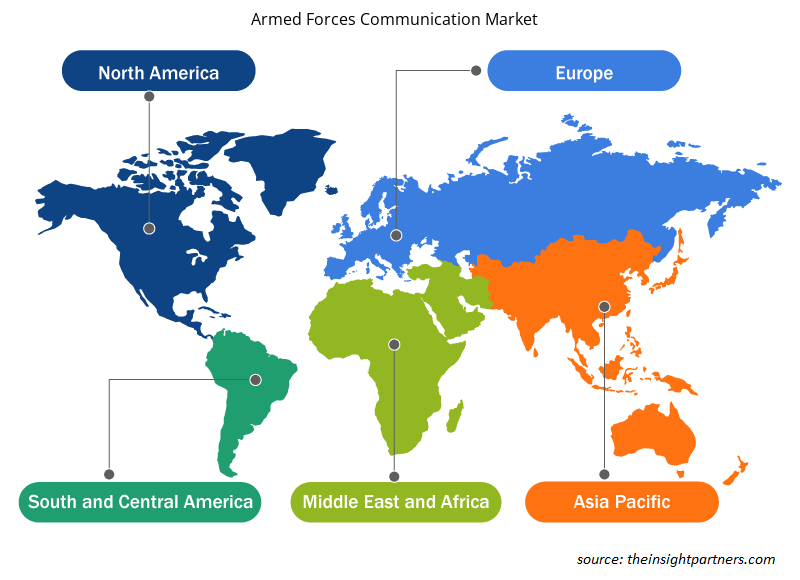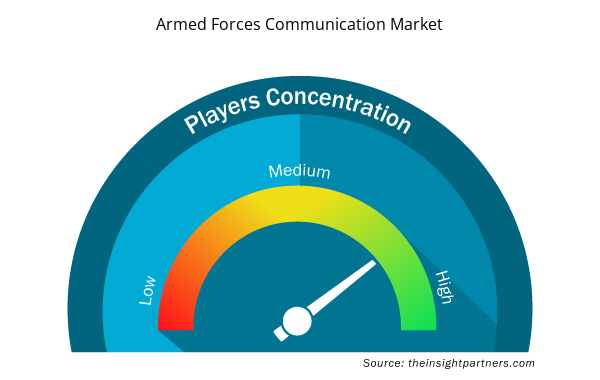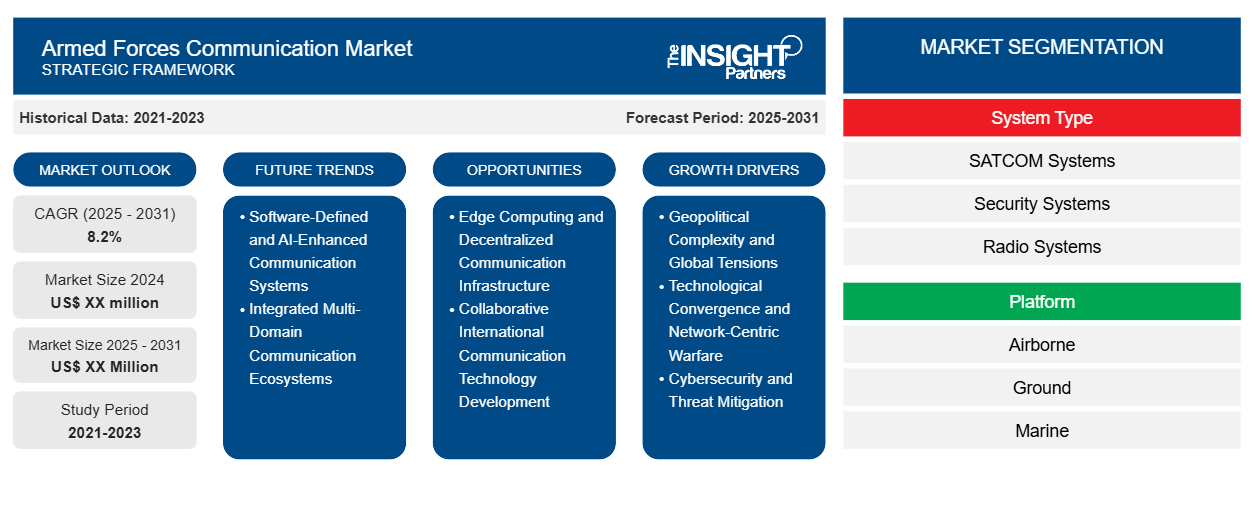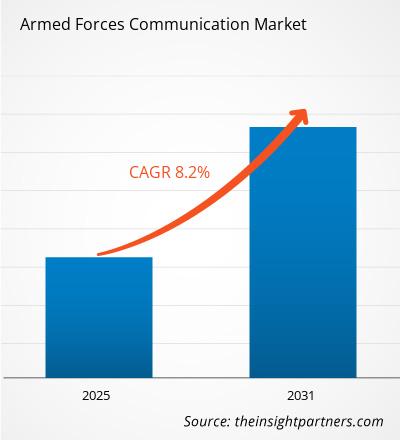Se espera que el mercado de comunicaciones de las fuerzas armadas registre una CAGR del 8,2 % entre 2024 y 2031, con un tamaño de mercado que se expandirá de US$ XX millones en 2024 a US$ XX millones en 2031.
El informe está segmentado por tipo de sistema (sistemas SATCOM, sistemas de seguridad, sistemas de radio, sistema de gestión de comunicaciones); plataforma [aérea (ala fija, ala rotatoria), terrestre (estaciones terrestres, vehículos de combate, vehículos blindados y de apoyo, soldados), marina (buques de combate y de transporte, buques de patrulla y apoyo, submarinos), sistemas no tripulados (UAV, UGV, UUV)]; aplicación (ISR, apoyo de combate, comando y control, otros). El análisis global se desglosa aún más a nivel regional y por países principales. El informe ofrece el valor en USD para el análisis y los segmentos anteriores.
Propósito del Informe
El informe Armed Forces Communication Market de The Insight Partners tiene como objetivo describir el panorama actual y el crecimiento futuro, los principales factores impulsores, los desafíos y las oportunidades. Esto proporcionará información a diversas partes interesadas del negocio, como:
- Proveedores/fabricantes de tecnología: Para comprender la dinámica cambiante del mercado y conocer las oportunidades potenciales de crecimiento, lo que les permitirá tomar decisiones estratégicas informadas.
- Inversionistas: Realizar un análisis exhaustivo de tendencias sobre la tasa de crecimiento del mercado, las proyecciones financieras del mercado y las oportunidades que existen en toda la cadena de valor.
- Órganos reguladores: Regular las políticas y vigilar las actividades del mercado con el objetivo de minimizar los abusos, preservar la confianza de los inversores y defender la integridad y la estabilidad del mercado.
Segmentación del mercado de comunicaciones de las fuerzas armadas
Tipo de sistema
- Sistemas SATCOM
- Sistemas de seguridad
- Sistemas de radio
- Sistema de Gestión de Comunicaciones
Plataforma
- Aerotransportado
- Suelo
- Marina
- Sistemas no tripulados
Solicitud
- ISR
- Apoyo de combate
- Comando y control
- Otros
Geografía
- América del norte
- Europa
- Asia-Pacífico
- América del Sur y Central
- Oriente Medio y África
Personalice este informe según sus necesidades
Obtendrá personalización en cualquier informe, sin cargo, incluidas partes de este informe o análisis a nivel de país, paquete de datos de Excel, así como también grandes ofertas y descuentos para empresas emergentes y universidades.
- Obtenga las principales tendencias clave del mercado de este informe.Esta muestra GRATUITA incluirá análisis de datos, desde tendencias del mercado hasta estimaciones y pronósticos.
Factores impulsores del crecimiento del mercado de comunicaciones de las fuerzas armadas
- Complejidad geopolítica y tensiones globales: Las crecientes incertidumbres geopolíticas y los conflictos regionales impulsan importantes inversiones en tecnologías de comunicación avanzadas para operaciones militares. Las naciones están dando prioridad a sistemas de comunicación robustos, seguros y resilientes que puedan operar en entornos conflictivos, asegurando el intercambio de información en tiempo real, la coordinación y la capacidad de toma de decisiones estratégicas en todas las unidades militares y estructuras de mando distribuidas.
- Convergencia tecnológica y guerra centrada en la red: la rápida integración de la inteligencia artificial, las comunicaciones cuánticas y las tecnologías avanzadas de cifrado está transformando los paradigmas de la comunicación militar. Las fuerzas armadas están invirtiendo fuertemente en infraestructuras de comunicación sofisticadas que permitan una interoperabilidad perfecta, un mejor conocimiento de la situación y una rápida transmisión de datos en diversos dominios operativos, incluidos los entornos terrestres, marítimos, aéreos y cibernéticos.
- Ciberseguridad y mitigación de amenazas: las crecientes y sofisticadas amenazas cibernéticas y las posibles vulnerabilidades de la infraestructura de comunicaciones están obligando a las fuerzas armadas a desarrollar redes de comunicación más resistentes, adaptables y seguras. Las inversiones en tecnologías de ciberseguridad de vanguardia, como el cifrado resistente a la tecnología cuántica, los sistemas avanzados de detección de amenazas y los protocolos de comunicación redundantes, se están volviendo fundamentales para mantener la integridad operativa.
Tendencias futuras del mercado de comunicaciones de las fuerzas armadas
- Sistemas de comunicación definidos por software y mejorados por IA: la migración hacia plataformas de comunicación basadas en inteligencia artificial y radio definida por software (SDR) está revolucionando las estrategias de comunicación militar. Estos sistemas adaptativos permiten una rápida reconfiguración, una utilización dinámica del espectro y un procesamiento inteligente de señales, lo que permite a las unidades militares mantener la eficacia de las comunicaciones en entornos operativos complejos y que cambian rápidamente.
- Ecosistemas de comunicación integrados en múltiples dominios: las fuerzas armadas están desarrollando progresivamente ecosistemas de comunicación integrales que integran sin problemas múltiples dominios operativos. Estas redes interconectadas aprovechan las tecnologías de comunicación satelitales, terrestres y emergentes para proporcionar un intercambio de información unificado y en tiempo real, mejorando la coordinación, la planificación estratégica y la capacidad de respuesta operativa en las diferentes ramas militares.
Oportunidades de mercado en las comunicaciones de las Fuerzas Armadas
- Infraestructura de comunicación descentralizada y computación de borde: la aparición de tecnologías de computación de borde presenta oportunidades significativas para desarrollar redes de comunicación descentralizadas y resilientes. Al distribuir capacidades computacionales y de comunicación más cerca de las unidades operativas, las fuerzas armadas pueden reducir la latencia, mejorar la capacidad de supervivencia de la red y crear arquitecturas de comunicación más flexibles y adaptables.
- Desarrollo colaborativo de tecnologías de comunicación internacionales: los crecientes desafíos de seguridad internacional están creando oportunidades para el desarrollo colaborativo de tecnologías y asociaciones estratégicas. Las iniciativas multinacionales de defensa, los programas de investigación conjuntos y los acuerdos de intercambio de tecnología pueden acelerar la innovación en tecnologías de comunicación, estandarizar protocolos de interoperabilidad y crear soluciones más rentables para las fuerzas armadas de todo el mundo.
Perspectivas regionales sobre el mercado de comunicaciones de las fuerzas armadas
Los analistas de Insight Partners explicaron en detalle las tendencias y los factores regionales que influyen en el mercado de comunicaciones de las fuerzas armadas durante el período de pronóstico. Esta sección también analiza los segmentos y la geografía del mercado de comunicaciones de las fuerzas armadas en América del Norte, Europa, Asia Pacífico, Oriente Medio y África, y América del Sur y Central.

- Obtenga datos regionales específicos para el mercado de comunicaciones de las fuerzas armadas
Alcance del informe sobre el mercado de comunicaciones de las fuerzas armadas
| Atributo del informe | Detalles |
|---|---|
| Tamaño del mercado en 2024 | XX millones de dólares estadounidenses |
| Tamaño del mercado en 2031 | US$ XX millones |
| Tasa de crecimiento anual compuesta (CAGR) global (2025-2031) | 8,2% |
| Datos históricos | 2021-2023 |
| Período de pronóstico | 2025-2031 |
| Segmentos cubiertos | Por tipo de sistema
|
| Regiones y países cubiertos | América del norte
|
| Líderes del mercado y perfiles de empresas clave |
|
Densidad de actores del mercado de comunicaciones de las fuerzas armadas: comprensión de su impacto en la dinámica empresarial
El mercado de comunicaciones de las fuerzas armadas está creciendo rápidamente, impulsado por la creciente demanda de los usuarios finales debido a factores como la evolución de las preferencias de los consumidores, los avances tecnológicos y una mayor conciencia de los beneficios del producto. A medida que aumenta la demanda, las empresas amplían sus ofertas, innovan para satisfacer las necesidades de los consumidores y aprovechan las tendencias emergentes, lo que impulsa aún más el crecimiento del mercado.
La densidad de actores del mercado se refiere a la distribución de las empresas o firmas que operan dentro de un mercado o industria en particular. Indica cuántos competidores (actores del mercado) están presentes en un espacio de mercado determinado en relación con su tamaño o valor total de mercado.
Las principales empresas que operan en el mercado de comunicaciones de las Fuerzas Armadas son:
- Grupo Thales
- Aselsan A.?.
- Sistemas BAE
- Sociedad Anónima Cobham
- Corporación HARRIS
Descargo de responsabilidad : Las empresas enumeradas anteriormente no están clasificadas en ningún orden particular.

- Obtenga una descripción general de los principales actores clave del mercado de comunicaciones de las fuerzas armadas
Puntos de venta clave
- Cobertura integral: el informe cubre de manera integral el análisis de productos, servicios, tipos y usuarios finales del mercado de comunicaciones de las fuerzas armadas, proporcionando un panorama holístico.
- Análisis de expertos: el informe se compila sobre la base de un profundo conocimiento de expertos y analistas de la industria.
- Información actualizada: El informe asegura relevancia comercial debido a su cobertura de información reciente y tendencias de datos.
- Opciones de personalización: este informe se puede personalizar para satisfacer los requisitos específicos del cliente y adaptarse adecuadamente a las estrategias comerciales.
Por lo tanto, el informe de investigación sobre el mercado de comunicaciones de las fuerzas armadas puede ayudar a abrir camino para descifrar y comprender el escenario de la industria y las perspectivas de crecimiento. Si bien puede haber algunas preocupaciones válidas, los beneficios generales de este informe tienden a superar las desventajas.
- Análisis histórico (2 años), año base, pronóstico (7 años) con CAGR
- Análisis PEST y FODA
- Tamaño del mercado Valor/volumen: global, regional, nacional
- Industria y panorama competitivo
- Conjunto de datos de Excel


- Nuclear Waste Management System Market
- Gas Engine Market
- Extracellular Matrix Market
- Small Satellite Market
- Electronic Health Record Market
- Green Hydrogen Market
- Grant Management Software Market
- Medical Enzyme Technology Market
- Quantitative Structure-Activity Relationship (QSAR) Market
- Underwater Connector Market

Report Coverage
Revenue forecast, Company Analysis, Industry landscape, Growth factors, and Trends

Segment Covered
This text is related
to segments covered.

Regional Scope
North America, Europe, Asia Pacific, Middle East & Africa, South & Central America

Country Scope
This text is related
to country scope.
Preguntas frecuentes
Some of the customization options available based on request are additional 3-5 company profiles and country-specific analysis of 3-5 countries of your choice. Customizations are to be requested/discussed before making final order confirmation, as our team would review the same and check the feasibility.
The report can be delivered in PDF/PPT format; we can also share excel dataset based on the request.
The major factors driving the armed forces communication market are:
1. Growing Demand for Electronic Communications
2. Demand for Security in Communication Systems
Some of the major trends driving the armed forces communication market are:
1. Demand for Satellite-Based Military Communications
2. Technological Advancements in Radio Communications
The Armed Forces Communication Market is estimated to witness a CAGR of 8.2% from 2023 to 2031
Trends and growth analysis reports related to Aerospace and Defense : READ MORE..
1. Thales Group
2. Aselsan A.?.
3. BAE Systems
4. Cobham PLC
5. HARRIS Corporation
6. Inmarsat PLC
7. Iridium Communications Inc.
8. L3 technologies, Inc.
9. Lockheed Martin Corporation
10. Saab AB
The Insight Partners performs research in 4 major stages: Data Collection & Secondary Research, Primary Research, Data Analysis and Data Triangulation & Final Review.
- Data Collection and Secondary Research:
As a market research and consulting firm operating from a decade, we have published and advised several client across the globe. First step for any study will start with an assessment of currently available data and insights from existing reports. Further, historical and current market information is collected from Investor Presentations, Annual Reports, SEC Filings, etc., and other information related to company’s performance and market positioning are gathered from Paid Databases (Factiva, Hoovers, and Reuters) and various other publications available in public domain.
Several associations trade associates, technical forums, institutes, societies and organization are accessed to gain technical as well as market related insights through their publications such as research papers, blogs and press releases related to the studies are referred to get cues about the market. Further, white papers, journals, magazines, and other news articles published in last 3 years are scrutinized and analyzed to understand the current market trends.
- Primary Research:
The primarily interview analysis comprise of data obtained from industry participants interview and answers to survey questions gathered by in-house primary team.
For primary research, interviews are conducted with industry experts/CEOs/Marketing Managers/VPs/Subject Matter Experts from both demand and supply side to get a 360-degree view of the market. The primary team conducts several interviews based on the complexity of the markets to understand the various market trends and dynamics which makes research more credible and precise.
A typical research interview fulfils the following functions:
- Provides first-hand information on the market size, market trends, growth trends, competitive landscape, and outlook
- Validates and strengthens in-house secondary research findings
- Develops the analysis team’s expertise and market understanding
Primary research involves email interactions and telephone interviews for each market, category, segment, and sub-segment across geographies. The participants who typically take part in such a process include, but are not limited to:
- Industry participants: VPs, business development managers, market intelligence managers and national sales managers
- Outside experts: Valuation experts, research analysts and key opinion leaders specializing in the electronics and semiconductor industry.
Below is the breakup of our primary respondents by company, designation, and region:

Once we receive the confirmation from primary research sources or primary respondents, we finalize the base year market estimation and forecast the data as per the macroeconomic and microeconomic factors assessed during data collection.
- Data Analysis:
Once data is validated through both secondary as well as primary respondents, we finalize the market estimations by hypothesis formulation and factor analysis at regional and country level.
- Macro-Economic Factor Analysis:
We analyse macroeconomic indicators such the gross domestic product (GDP), increase in the demand for goods and services across industries, technological advancement, regional economic growth, governmental policies, the influence of COVID-19, PEST analysis, and other aspects. This analysis aids in setting benchmarks for various nations/regions and approximating market splits. Additionally, the general trend of the aforementioned components aid in determining the market's development possibilities.
- Country Level Data:
Various factors that are especially aligned to the country are taken into account to determine the market size for a certain area and country, including the presence of vendors, such as headquarters and offices, the country's GDP, demand patterns, and industry growth. To comprehend the market dynamics for the nation, a number of growth variables, inhibitors, application areas, and current market trends are researched. The aforementioned elements aid in determining the country's overall market's growth potential.
- Company Profile:
The “Table of Contents” is formulated by listing and analyzing more than 25 - 30 companies operating in the market ecosystem across geographies. However, we profile only 10 companies as a standard practice in our syndicate reports. These 10 companies comprise leading, emerging, and regional players. Nonetheless, our analysis is not restricted to the 10 listed companies, we also analyze other companies present in the market to develop a holistic view and understand the prevailing trends. The “Company Profiles” section in the report covers key facts, business description, products & services, financial information, SWOT analysis, and key developments. The financial information presented is extracted from the annual reports and official documents of the publicly listed companies. Upon collecting the information for the sections of respective companies, we verify them via various primary sources and then compile the data in respective company profiles. The company level information helps us in deriving the base number as well as in forecasting the market size.
- Developing Base Number:
Aggregation of sales statistics (2020-2022) and macro-economic factor, and other secondary and primary research insights are utilized to arrive at base number and related market shares for 2022. The data gaps are identified in this step and relevant market data is analyzed, collected from paid primary interviews or databases. On finalizing the base year market size, forecasts are developed on the basis of macro-economic, industry and market growth factors and company level analysis.
- Data Triangulation and Final Review:
The market findings and base year market size calculations are validated from supply as well as demand side. Demand side validations are based on macro-economic factor analysis and benchmarks for respective regions and countries. In case of supply side validations, revenues of major companies are estimated (in case not available) based on industry benchmark, approximate number of employees, product portfolio, and primary interviews revenues are gathered. Further revenue from target product/service segment is assessed to avoid overshooting of market statistics. In case of heavy deviations between supply and demand side values, all thes steps are repeated to achieve synchronization.
We follow an iterative model, wherein we share our research findings with Subject Matter Experts (SME’s) and Key Opinion Leaders (KOLs) until consensus view of the market is not formulated – this model negates any drastic deviation in the opinions of experts. Only validated and universally acceptable research findings are quoted in our reports.
We have important check points that we use to validate our research findings – which we call – data triangulation, where we validate the information, we generate from secondary sources with primary interviews and then we re-validate with our internal data bases and Subject matter experts. This comprehensive model enables us to deliver high quality, reliable data in shortest possible time.


 Obtenga una muestra gratuita de este informe
Obtenga una muestra gratuita de este informe